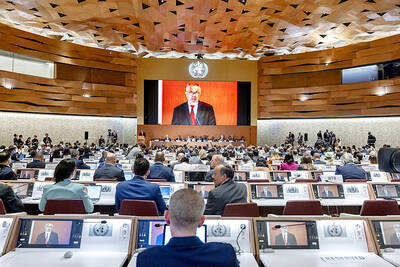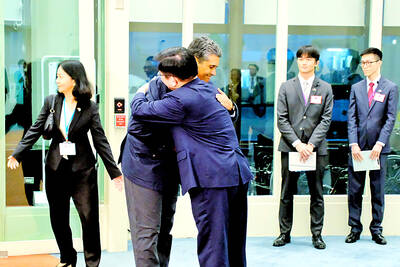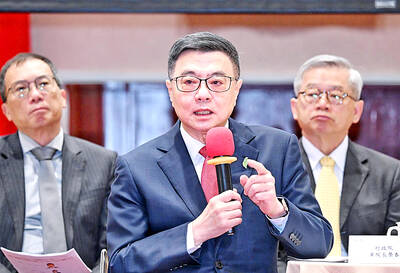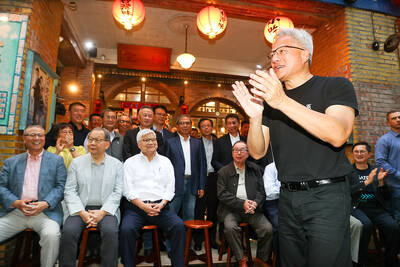The Kaohsiung City Government’s Mass Rapid Transit Bureau said yesterday that a revised plan for an extension of its two MRT lines is almost finished and would be submitted to the Ministry of Transportation and Communications next month.
The plan would extend the system’s Red Line and Orange Line by a total of 23.4km, the bureau said.
The Red Line has been in service for five months and the Orange Line is set to open next month. As soon as the Orange line is up and running, the city government will help the Pingtung County and Kaohsiung County governments push for the extension plan to create a comprehensive regional mass transit system, said Lee Yeong-kuen (李永坤), a division chief at the bureau.
The Red Line now runs from Siaogang Station (小港) in Kaohsiung City north to Gangshan Station (岡山) in Kaohsiung County, covering 28.3km. The Orange Line will run 14.4km from the city’s Sizihwan Station (西子灣) to Daliao Station (大寮) in the county.
Lee said that the city government drew up the extension plans in 2006 and had sent them to the ministry several times for approval.
Each time the ministry asked for the plan to be revised over concerns that the extensions might not be cost-effective since they would follow almost the same path as the railway line which links Pingtung and Kaohsiung.
The new plan calls for an extension of the Red Line northward by 9.4km to the Luchu Science Park (路竹科學園區) in Kaohsiung County, and an extension of the Orange Line southward by 14.4km to the Pingtung sugar factory in Pingtung City.
Lee said that the extensions would lead to a significant increase in MRT passenger numbers, adding that the only question now is whether the benefits of the extensions will outweigh the massive investment needed to turn the plan into a reality.
The Red Line extension is expected to cost about NT$16.2 billion (US$516.6 million), while the Orange Line extension’s price tag is NT$31.8 billion, Lee said.

RESOLUTIONS DEBATE: Taiwan’s allies said that UN and WHA resolutions cited by China and other nations ‘do not determine Taiwan’s participation in WHO activities’ A proposal to invite Taiwan to this year’s World Health Assembly (WHA) was rejected on Monday, resulting in Taipei’s absence from the annual meeting for a ninth consecutive year, although partners spoke up for Taiwan’s participation at the first day of the meeting. The first agenda item after the opening was a “two-on-two debate” on a proposal to invite Taiwan to participate at the WHA as an observer. Similar to previous years, two countries made statements in favor of the proposal, while two others expressed their opposition. Philippine Secretary of Health Teodoro Herbosa, president of the 78th WHA, accepted the WHA General Committee’s

Palauan President Surangel Whipps Jr arrived in Taiwan last night to kick off his first visit to the country since beginning his second term earlier this year. After arriving at Taoyuan International Airport at around 6:30 pm, Whipps and his delegation were welcomed by Minister of Foreign Affairs Lin Chia-lung (林佳龍). Speaking to gathered media, the Palauan leader said he was excited and honored to be back in Taiwan on his first state visit to Taiwan since he was sworn in this January. Among those traveling with Whipps is Minister of State Gustav N. Aitaro, Public Infrastructure

Premier Cho Jung-tai (卓榮泰) on Friday laid out the Cabinet’s updated policy agenda and recapped the government’s achievements ahead of the one-year anniversary of President William Lai’s (賴清德) inauguration. Cho said the government had made progress across a range of areas, including rebuilding Hualien, cracking down on fraud, improving pedestrian safety and promoting economic growth. “I hope the public will not have the impression that the Cabinet only asked the legislature to reconsider a bunch of legal amendments,” Cho said, calling the moves “necessary” to protect constitutional governance and the public’s interest. The Cabinet would work toward achieving its “1+7” plan, he said. The

Nvidia founder and CEO Jensen Huang (黃仁勳) hosted a dinner in Taipei last night with key Taiwanese suppliers to celebrate the successful mass production of the company’s new Blackwell AI systems. Speaking to the media earlier yesterday, Huang thanked Nvidia’s Taiwanese partners for their contributions to the company’s ecosystem, while also sharing his plans to meet with Taiwan Semiconductor Manufacturing Co (TSMC) founder Morris Chang (張忠謀). In response to rumors that Nvidia will launch a downgraded Hopper H20 chip for China in July, Huang dismissed the reports, saying, “That is not true.” He clarified that there